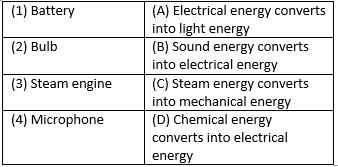HOTS Questions: Work & Energy - Class 9 MCQ
25 Questions MCQ Test Science Class 9 - HOTS Questions: Work & Energy
Statement A: Any physical or mental activity is termed as work done in physics.
Statement B: Work is said to be + ve work done when the body is displaced in the direction of applied force. Which of the two statements is true?
Statement B: Work is said to be + ve work done when the body is displaced in the direction of applied force. Which of the two statements is true?
Statement A: An aeroplane flying at an altitude possesses only K. E.
Statement B: An aeroplane flying at an altitude possesses both K. E and P. E.
Which of the two statement is true
A ball is dropped from a height ‘h’. The velocity of the ball when it reaches the ground is 10 m/s. Find ‘h’ (g = 10ms−2)
An electric lamp of 100w is used for 5 hours per day calculate the units of energy consumed by lamp in one day
Statement A: Mechanical energy of a system is always conserved.
Statement B: The total energy of the system is always conserved.
Which of the two statements is true?
In which of the following activities the work is said to be done?
When you compress a coil spring you do work on it. The elastic P. E energy
A certain household has consumed 250 units of energy during a month. How much energy is this in joules?
Which of the following is a non metal that remains liquid at room temperature?
P.E of a spring increases when it is in the state of
Work done by the gravitational force of earth on a satellite along a circular path is
9800 joule of energy was spent to raise a mass of 50kg, the mass was raised to a height of
What happens to the kinetic energy of a freely falling object which eventually stops on reaching the ground?
The linear momentum of a body of mass 2kg is 16kgms−1. What is its K. E?
Which of the following is unit of energy
A. Newton metre
B. Joule
C. Kilowatt hours
D. Kilowatt
|
88 videos|369 docs|67 tests
|




















